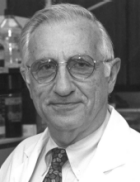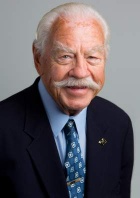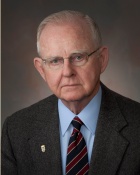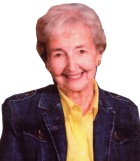Classnotes - 1950s
Alfred E. Falcone, DDS ’47, MD ’50, is a 94-year-old retired plastic surgeon, in good health, who lives in Jamestown, NY. The following are a collection of memories he has of medical school.
“I was 18 years old when I was accepted into UB Dental School, by virtue of a wartime accelerated program. I graduated dentistry in February 1947 at age 21. At the time, Dean Koch of the UB Medical School offered an acceptance to the top three dental graduates. They would enter as sophomores and advance to the third year if they passed Part 1 of the National Medical Boards. I accepted his proposal.”
“I worked at the Howard Johnson ice-cream store located at Delaware and North Streets. I was an evening short-order cook and filled in at the front ice-cream counter. A frequent customer wearing a small tipped hat was Dr. Stockton Kimball. I would give him extra portions at no charge knowing that he was involved in some way with the medical school.”
“I arranged to attend lectures in the second year medical, but I was excused from the long labs. Instead I spent the time reviewing for the boards. The anatomy board questions from the previous five years were available. I noted a lack of questions regarding circulation and the diaphragm. I studied these in depth and the board exam was all about circulation and the diaphragm. In biochemistry, I asked the teacher what was most topical at that time. He responded, ‘Lipids.’ I studied lipids thoroughly and the board exam was mostly about lipids. So I lucked out and came in twelfth in a class of 73.”
“There was a great division between medical students and the vivacious dental students. Medical students were more reserved, quiet and dedicated to the study of medicine. The difference was obvious and I had to take on the roll of a serious student. The class had nine women, which was new to me. They were excellent students and blended in well. In addition there was one black fellow, which was a revelation to me. His name was James C. Dunn and he was from Lackawanna. He was the youngest individual in a class of 73. Jim became a good friend and we blended in very well. The biggest and best fraternity in medical school was Nu Sigma Nu. Jim had such a great following and personality that we wanted him in Nu Sig. He joined much to our pleasure. When the national chapter of Nu Sigma Nu heard about it they were upset. ‘What if Dr. Dunn were to travel in Georgia and Alabama and wanted to stay at Nu Sig house?’ Our response was ‘So what!’ The Buffalo chapter was then expelled until graduation in 1950.
Once Jim and I were partners on call for obstetrics in the call room behind the Buffalo General Hospital. In the early evening we had time to chat. I had the nerve to ask him how the patients reacted to a black doctor. He said he had no problem—‘a doctor is a doctor.’ When I was a resident in Syracuse [my hometown], I received a phone call from Jim and he asked me to be his best man at his wedding. Indeed I was honored and accepted. When his first son was born, he asked me to be godfather. I was again overjoyed. Just a continuation of our friendship in medical school. I refer you to you to read his most interesting obituary from last year, as he made it to almost 91. Dr. James C. Dunn, Tucson, AZ.”
The following are some experiences in the third-and fourth-years medical school.
“The chief of surgery at the Buffalo General was Dr. Payne. We referred to the Buffalo General as the “’House of Pain.’ Buffalo General was the ultimate in private hospitals, and many times the students could not examine private patients. Not so at the Meyer Memorial. It was an Erie County hospital with many ward or welfare patients. Trolley car #13 took us from Main and High Streets over Delevan to the hospital.
“The wards at Meyer Memorial were often four to six occupied beds with sectional curtains. One such ward had only elderly males on respirators. Dr. Levine was our instructor and started with the first bed on the left. The patient was an elderly male sitting to ease his breathing. Dr. Levine went on, mentioning the therapy—antibiotics such as penicillin measured in small units, oxygen and so on. The next bed was another male probably in his eighties. ‘What to do?’ asked Dr. Levine. We knew the answer: penicillin, oxygen, etc. ‘No,’ said Dr. Levine, ‘just congratulate him.’ Such was our lesson. An eighteen-year old white girl was confined to a psychiatric ward. Her wrong doing was she was dating a black man.”
“At the Meyer Memorial the chief of surgery was Dr. John Stewart. He was a stalwart and well respected. It was an honor to assist him even though the student was redundant and apart. One day I scrubbed to the elbows for ten minutes and entered the operating groom. The surgery was underway when the circulating nurse hurried me out of the room. I had forgotten to put on a mask. The least service I enjoyed was psychiatry. Too much talking with uncertain results, unlike surgery where one would cut, tie and be done with it. I knew where my future lied.”
“We saw little of our classmates since we went off in pairs and only assembled for occasional lectures. With my being a dentist, I was more relaxed as a medical student since I had something to fall back on if I did not succeed. I succeeded. Toward the end of medical school, we had to select a hospital of our choice for internship. I chose the ‘three M’s’—the Royal Victoria in Montreal, the Millard Fillmore, and lastly Jackson Memorial in Miami. The Royal Victoria was an immediate no. Millard Fillmore was slow to respond, so I chose Jackson Memorial. A good choice for some sunshine after seven years in Buffalo.”

Alvin Volkman, MD ’51
—Academic physician-leader, distinguished pathologist
Alvin Volkman, MD ’51, died peacefully at his home in Greenville, N.C., on April 11, 2018, surrounded by family. He was 91.
A native of Brooklyn, N.Y., Volkman received a B.S. degree from Union College in 1947. After earning his medical degree at the Jacobs School of Medicine and Biomedical Sciences in 1951, he served his residency at Western Reserve University (now Case Western Reserve University), after which he completed a D.Phil. at the University of Oxford, England, in 1963.
Volkman moved to Greenville, N.C, in 1977 to help establish East Carolina University’s Brody School of Medicine, where he served as professor of pathology. From 1989 to 1995 he held the position of associate dean for research and graduate studies at the school and took great pleasure in selecting the next generation of doctors and scientists. In addition, he served as a medical examiner at Pitt County Memorial Hospital. He earned the honor of professor emeritus upon his retirement.
Volkman’s distinguished medical career included a research fellowship at Western Reserve University School of Medicine and residency at Peter Bent Brigham Hospital, Boston, Mass. He was an assistant professor of pathology at the College of Physicians and Surgeons, Columbia University, 1960-1966 and an associate member at the Trudeau Institute, Saranac Lake, N.Y., 1966-1977.
His most notable scientific work provided a fundamental understanding of a major aspect of how our immune system works by proving that monocytes (white blood cells) originate in the bone marrow.
Volkman was a veteran of the Korean War. As a lieutenant, he served as ship’s doctor for a destroyer group in the U.S. Naval Reserve, 1954-1956.
He had a passion for the arts, a love of the outdoors, and was an avid fisherman. The Outer Banks was a favorite retreat for him to connect with the ocean as well as his cherished friends and family.
He was preceded in death by his brother, Jerome, and his wives, Winifred Joan and Carol.
He is survived by his wife, Suzanne; six children, Karl Fredrick, Xiamen, China; Nicholas (Virginia), Sedona, Ariz.; Rebecca (Michael) Evans, Granville, Ohio; Gretchen (Jamie) Werrell, Rock Hill, SC; Deborah (David) Falls, Belfast, ME; Natalie, New York, NY; one stepson, Jeffrey (Sonya) Moore, Westfield, NJ; 14 grandchildren and 6 great-grandchildren.

Edmond J. Gicewicz, MD ’56
—Physician, athlete, generous donor
Edmond J. Gicewicz, MD ’56, one of UB’s most loyal supporters died on March 28, 2018. He was 89.
Gicewicz—affectionately known as “Doc”—was a three-sport athlete at UB, a longtime member of the UB Council and a past president of the UB Alumni Association. For nearly three decades, he served as the UB football team physician.
A 1952 graduate of UB, Gicewicz was a standout football, basketball and baseball player for the Bulls. He went on to earn a medical degree from UB in 1956 and served as the football team physician for 27 years. He was elected to the UB Athletics Hall of Fame in 1966 and the Greater Buffalo Sports Hall of Fame in 1999.
Among his many leadership roles at UB, Gicewicz was president of the UB Medical Alumni Association and founder and first medical director of the University Sports Medicine Institute, which continues to thrive today.
He held appointments as an assistant professor of clinical surgery and an assistant professor of clinical orthopaedics in the Jacobs School of Medicine and Biomedical Sciences. He was honored by his alma mater with the Distinguished Alumni Award in 1977, the prestigious Samuel P. Capen Chancellor’s Award in 1978 and the UB President’s Medal in 2013.
The Gicewicz family has remained generous supporters of the Bulls’ athletic programs. In 2007, the UB Athletics Hall of Fame was renamed the Dr. and Mrs. Edmond J. Gicewicz Family UB Athletics Hall of Fame. In 2015, the new state-of-the-art club seating section at UB Stadium was named the Edmond J. Gicewicz Club.
Gicewicz is survived by his wife, Connie; their five children, Suzanne, Julie, Alicia, E. Richard and Gregory; and 11 grandchildren.

Fred Lee, MD ’56, died on January 15, 2016 at the age of 85.
A native of Buffalo, Lee was one of seven children born to parents who were immigrants from China. During medical school, Lee met his future wife, Ethel. After dating for several years, the couple eloped to Maryland, where they were confronted with laws designed to prevent mixed-race marriages.
After medical school, Lee took a surgery internship at the University of Chicago, followed by a radiology residency at Harvard University’s Peter Bent Brigham Hospital in Boston. Upon completion of his residency, Lee was drafted into the U.S. Army and posted to a hospital on Okinawa from 1960-1962. After leaving the military, he took a faculty position at the University of Rochester. In 1964 he joined the medical staff at St. Joseph Mercy Hospital in Ann Arbor, MI, where he practiced for 25 years.
Lee was an expert in ultrasound. In 1985, during a trial of a new ultrasound machine, he diagnosed his own prostate cancer. He responded by conducting research and became a pioneer in the diagnosis, staging and treatment of prostate cancer.
In 1990, Lee joined Crittenton Hospital in Rochester, MI, where he practiced until 2015. He won numerous awards for his work in prostate cancer, was named a Michigan Man of the Year in 1986, and in 1987 was featured in a PBS special with Elizabeth-Kubler Ross, titled “The Windstorms of Life”.
Lee is survived by his wife, Ethel, his children: Alexa Lee (Matthew DeGenaro, Ann Arbor, MI), Suzanne Lee (Peter Pryde, Madison, WI), Fred Lee Jr. (Marjorie DiMaggio, Madison, WI), Amy Lee (Stathi Mexas, Berkeley, CA), and Andrew Lee (New York, NY); six brothers and sisters; and his beloved grandchildren.

William W. Pfaff, MD ’56, died on March 6, 2014, from prostate cancer.
A native of Rochester, NY, Pfaff earned an undergraduate degree from Harvard University before attending UB Medical School. He trained at the University of Chicago, the National institutes of Health and Stanford University. In 1965, he joined the faculty of the University of Florida, where he was promoted to full professor in 1971.
Pfaff performed the first successful kidney transplant in Florida in 1966 with Robert Cade, MD, and Dana Shires, MD. He maintained an active practice in general surgery, which he regarded as his primary role, with transplantation his avocation.
Pfaff organized the first transplant program in Florida and will be remembered for his leadership and ability to bring people together to attain this goal.
A voracious reader, Pfaff never stopped learning. He was an avid sailor, the original “foodie,” and made a point of finding joy in every day.
He was married to Patricia Ann Clark Pfaff for 53 years. They have four daughters, Nancy Loftus, Karen Fluman, Peggy Pfaff-Walton and Cathy Sak, and nine grandchildren.
Axel Anderson, MD ’57
Axel Anderson, MD ’57, died on October 11, 2021. He was 92.
A native of Olean, New York, Anderson was the oldest of five, and took on responsibility early in life, working in his father's grocery store. During his first attempt to join the Armed Forces at age sixteen, he was diagnosed with tuberculosis, and was sent to a sanitarium for two years, where he was one of a few survivors. It was there that he developed a strong sense of empathy and the desire to become a doctor. He worked his way through St. Bonaventure at a furniture factory and went on to graduate in 1953.
He received his medical degree from UB in 1957. While in medical school, he met and married Joanna, a nurse in training. His first son, Axel IV, was born in Buffalo. He served as a lieutenant in the Medical Corps of the Navy in Virginia, where his second son, Michael, was born. He then completed his internship at the U.S. Naval Hospital in Jacksonville, Florida. He completed a three year residency in internal medicine at Orange Memorial Hospital in Orlando, Florida in 1963. He then completed his formal education at Grady Memorial Hospital in Atlanta, Georgia, in hematology-oncology.
He then returned to Orlando and was in private practice with Dr. James Cook from 1963 until 1975. He then started Hematology Oncology Associates of Central Florida, which eventually merged with MD Anderson Cancer Center to become one of the premier cancer treatment centers in the area. Despite the large and growing nature of his medical practice, he always focused on the individual. His days consisted of early morning rounds on his hospitalized patients, office appointments, followed by early evening rounds again in the hospital. His appointments were numerous; some of them included assistant professor at University of Florida; delegate, Florida Medical Association; chief internal medicine and chief of staff, Orlando Regional Medical Center 1981-1983.
Axel is survived by his loving wife of 65 year, Joanna, his children, Axel Anderson IV (Sharon) of Winter Park, FL, and Michael Anderson (Temple) of Windermere, FL, and grandchildren.

Ronald E. Batt, MD ’58, PhD
—Professor of obstetrics and gynecology and historian
Ronald E. Batt, MD ’58, PhD, a professor in the Department of Obstetrics and Gynecology died at home on April 25, 2017 after a brief illness. He was 83.
A native of Buffalo, Batt graduated from UB medical school in 1958 and completed residencies and fellowships at Buffalo hospitals, Harvard Medical School and the Mayo Clinic.
Batt was in private practice in Buffalo from 1970 to 1990, and in 1995 he joined the medical school’s faculty. He was known internationally for his work on endometriosis and its pathophysiology and for developing his theory of developmental müllerian diseases, or müllerianosis.
After retiring from clinical practice, Batt pursued an interest in history and completed a PhD in the subject in 2009. His thesis research became the seminal book, The History of Endometriosis, which was published in 2013. At the time of his death, Batt was working on the second volume of this book.
Batt was an American College of Obstetricians and Gynecologists Ortho-McNeil fellow in the History of American Obstetrics and Gynecology (2004), was recognized by UB with the Medical Alumni Lifetime Achievement Award (1998) and in 2015, received the prestigious Harry Reich Award for Pioneering Work in the Science and Treatment of Endometriosis from the Endometriosis Foundation of America.
Batt was a fixture at grand rounds and faculty meetings, always willing to share his historical perspective and kind encouragement.
He is survived by his wife, Kathleen; his children: Paula Wilson, Douglas Batt, Thomas Batt, Neil Batt, Jennifer Michalski, and John Batt; and step-children: William Cansdale, James Cansdale, Suzanne Gill, Timothy Cansdale, John Cansdale and Mark Cansdale.
Michael Thomas Genco, MD '58, a leader in the medical community, died Nov. 28 in Sisters of Charity Hospital after a short illness. He was 89.
Born in Buffalo, the oldest of four children, he grew up on the city’s West Side and Central Park neighborhoods. He worked in his family’s drug stores and later in his father’s Blue Dew and Diaper Pure factory. He attended St. Mark’s School and was a 1951 graduate of St. Joseph’s Collegiate Institute. He attended the University of Buffalo for both his undergraduate and medical degrees. On June 27, 1959, he married the former Ann Collard.
He served as a medical officer in the Navy from 1959 to 1961 in Quantico, Va. From 1962 to 1965 he was a resident in neurology at Buffalo General Hospital and University Hospitals in Cleveland.
Dr. Genco served in private practice from 1965 to 1992. Together with Dr. Donald Ehrenreich, he founded Buffalo Neurological Associates in 1967. The practice grew to five neurologists and merged with the Buffalo Medical Group in 1979. In addition to his successful medical practice, Dr. Genco in 1983 served as president of Buffalo General Hospital's medical and dental staff.
In 1991, he was selected as the first full-time medical director of the Buffalo Medical Group. Under his guidance, the Buffalo Medical Group expanded to 90 physicians, and he personally oversaw the construction and opening of the Essjay Road office in Amherst. In addition, he taught as an associate clinical professor for many years at the UB Medical School. He retired in 1997.
Guided by his Catholic faith, Dr. Genco was committed to helping others and improving their quality of life. Reflecting on his father’s legacy, his son Eugene said: “This happened at least a couple dozen times: I would meet a person, and they would tell me that a family member or themselves had been referred to my dad because they had a difficult medical issue. They would inevitably tell me that my dad gave them a clear and straightforward diagnosis in a compassionate manner and that they were so thankful. It is a powerful and humbling experience to have people tell you that your father made such a difference in their lives.”
Dr. Genco served on the board of the Buffalo Club from 1983 to 1986, when he was elected president. He was on the board of the Buffalo Country Club from 1989 to 1992, serving as president in 1992. He served on the board of the Automobile Club of Western New York from 1989 to 1991, serving as its chair in 1991.
A member of St. Joseph's Collegiate Institute Board of Trustees from 1986 to 1991, he was honored by the school for career achievement in 1990. He also served on the Board of Trustees for Medaille College, now Medaille University, in the 1980s.
In 1986 he and his wife constructed a second home in Crescent Beach in Fort Erie, Ont., and spent summers and family Christmases there for more than 30 years.
Dr. Genco was an avid golfer, squash and bridge player, playing in a weekly bridge game up to the time of his death.
He was immensely proud of his Italian heritage and loved to stop by Niagara Street for a plate of clams or go to the former Romanello’s Roseland on Rhode Island Street for a pasta dinner.
Surviving in addition to his wife of 63 years are two daughters, Ellen Genco and Susan Genco; three sons, Frank, Eugene and Gregory P.; a sister, Mary Frances Breen; and eight grandchildren.
A memorial Mass is planned in July 2023.

Dorothy Rasinski Gregory, MD ’59
—One of the first women in the country to earn law and medical degrees
Dorothy Rasinski Gregory, MD ’59, an endocrinologist and one of the first women in the country to earn both law and medical degrees, died July 31, 2022 in Long Beach, CA. She was 94.
Rasinski Gregory was raised in Buffalo, NY, and earned an undergraduate degree at Cornell University, where she also attended law school. She was admitted to the New York Bar in 1951.
In the mid-1950s, Rasinski Gregory and her brother, Julius, applied to the UB Medical School without the other knowing it (neither knew the other was even considering this). Each was admitted, and they graduated in the same class in 1959.
Board certified in internal medicine and legal medicine, Rasinski Gregory practiced in Fullerton, CA, where she was a well-known diabetic specialist. She later joined the Legal Medicine Division of the Armed Forces Institute of Pathology in Washington, D.C. She also served as director of Medical-Legal Affairs for the Department of Veterans Affairs at the Washington Central Office and as a liaison member of the President’s Commission for the Study of Ethical Problems in Medicine and Biomedical and Behavioral Research.
Rasinski Gregory was transferred to the VA Medical Center in Long Beach, CA, where she served as associate chief of staff for education and acting chief of staff. At that time, she also joined the faculty at the University of California, Irvine, School of Medicine.
Rasinski Gregory served as president of the American College of Legal Medicine (the only woman to have held that office) and was a member of the editorial board of the Journal of Legal Medicine, as well as numerous other journals.
After retiring, she joined the VA National Ethics Advisory Board.
She is predeceased by her husband of 50 years, James B. Gregory, and daughter, Linda Young Strong. She is survived by her brother, Julius Rasinski (Ellen), grandchildren, great-grandchildren and nieces and nephews.
Julius, now 92, is retired from a large family practice in Southern California. During his career, he was team physician for the California Angels baseball team and the Los Angeles Rams football team.